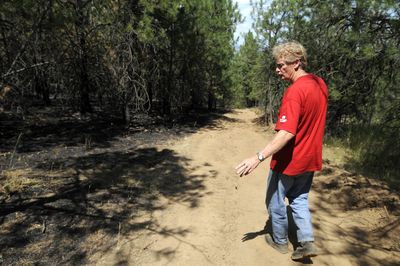Fire defense measures can turn flames away
Some insurers require steps in risky spots

Glen MacPhee started trimming trees and clearing debris from his 85-acre property in the Dishman Hills when he bought it about four years ago. The retired teacher spent five summers fighting wildfires and knew the area was at risk. He also knew what he needed to do to protect it.
“People will have a $500,000 home, but they won’t spend $10,000 or $15,000 to go into the forest and make it safe,” MacPhee said.
Now MacPhee credits his actions and those of his neighbor Harry Hanover with helping save their property from the Valley View fire. The fire never moved beyond his self-made fire line.
Similar efforts saved other homes and properties throughout the area, fire officials say, and insurance companies tout those efforts as key to protecting homes.
“If people really looked at what happened here last Thursday and the homes that made it through and those that didn’t, they would see the benefit of doing the work,” said Spokane Valley Fire Chief Mike Thompson.
MacPhee, who spearheaded the Central Valley School District’s environmental education program in the 1980s, sees his property as an investment, a conservation effort and a place for recreation.
He’s up there just about every day, hunting, relaxing or trimming and clearing trees and debris. He learned about the wildfire while watching the 5 p.m. news at his home a few blocks from the property’s gate along Sunderland Road.
Half an hour later, he was clearing brush and digging the fire line. Armed with a Pulaski tool – a combination ax and hoe – and a chain saw, the 59-year-old said he was prepared to be there for 24 hours.
He didn’t need to be. The fire roared up the hill, burning about 40 acres of his land. But only three or four acres burned clear through, leaving behind skeletal remains of ponderosa pines. The brush clearing and tree thinning he’d dedicated himself to over the years prevented the fire from crowning. It couldn’t hopscotch from treetop to treetop as it did in so many other areas of the blaze, which burned more than 1,000 acres.
“It didn’t have the fuel,” he said.
By 3:30 a.m., with the temperature dropping and humidity rising, the fire was contained behind a fire line first dug by MacPhee, Hanover and other volunteers, then finished by firefighters with a tractor. The group headed home.
MacPhee says he can live with most of the torched acreage. The ground might be burned, but most of the trees survived. The trees that did ignite grew in the areas he hadn’t yet cleared. The difference is remarkable – torched ponderosa trunks and brown needles stand yards from healthy green ones.
“I can live with this,” he said, pointing to a healthy-looking tree growing out of scorched land.
MacPhee’s work mirrors the fire-prevention efforts getting attention from insurance companies.
“They’re taking a strong look at the properties they insure in these high-risk wildfire areas,” said Darrin Sanger, spokesman for the NW Insurance Council. “Some companies are making recommendations and requiring their policyholders to make certain modifications.”
But the efforts can’t just be promoted by insurance agents worried about protecting investments – wildfire prevention should be on the minds of every forest homeowner, said Tim Coleman, wilderness campaign director for Conservation Northwest.
“It’s got to become something that people think about in a much bigger way,” Coleman said. “You can’t just think about it in July and August and early September. You’ve got to think about it all year round.”
Trimming and thinning trees, installing fire-resistant roofs and planting plenty of green grass around a home are crucial steps. Clearing adjacent forestland of downed branches, brush, shrubbery and other debris is another.
“For the person who likes the natural look, it’s not for them,” MacPhee said. “But the natural look is also a burned forest.”